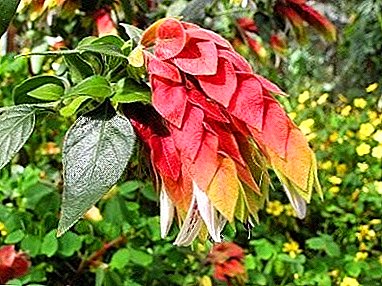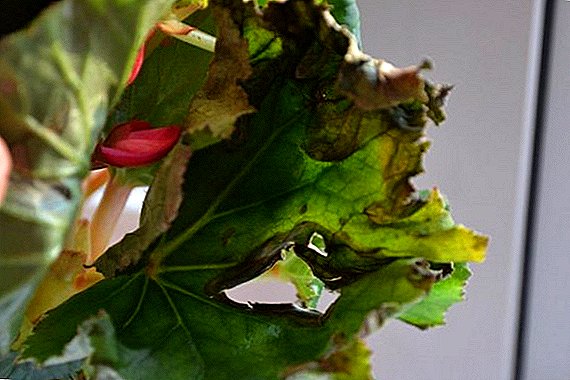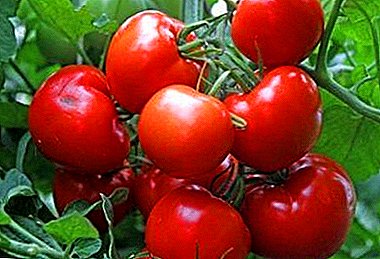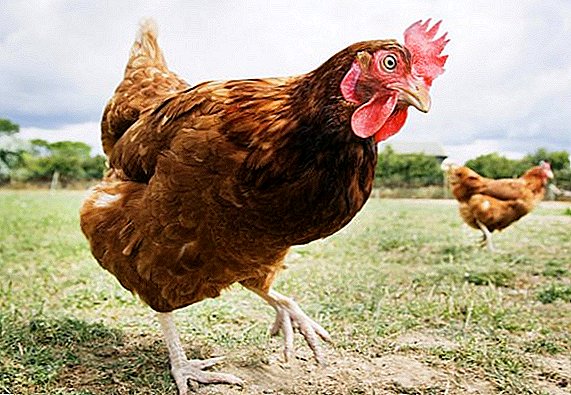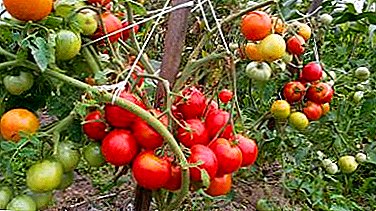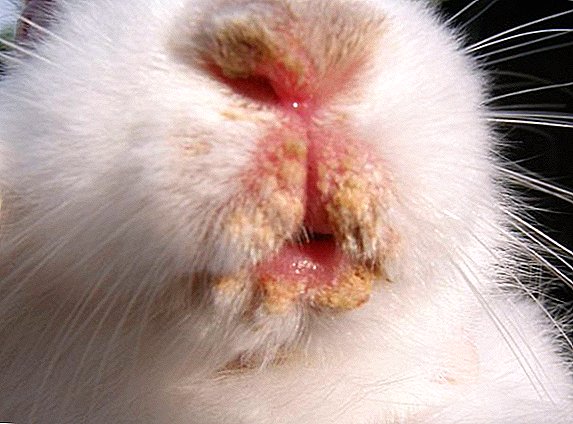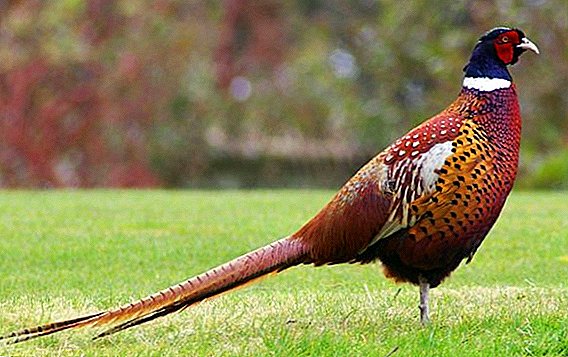 Today we will talk about the pheasant - a bird, which is a popular hunting object, as well as a symbol of South Dakota in the United States. This large beautiful bird is a relative of an ordinary chicken and also feels rather well on a farmer's farmstead. In our area, both wild and domesticated pheasants look exotic, but it is possible to breed them here.
Today we will talk about the pheasant - a bird, which is a popular hunting object, as well as a symbol of South Dakota in the United States. This large beautiful bird is a relative of an ordinary chicken and also feels rather well on a farmer's farmstead. In our area, both wild and domesticated pheasants look exotic, but it is possible to breed them here.
Description and external differences
Pheasants have pronounced sexual dimorphism. This means that it is quite simple to distinguish a female from a male, even in appearance.
Females:
- have a dull color;
- the plumage is light brown or grayish-sand color, there are brown spots;
- average weight is 1.6-1.8 kg.
You will probably be interested in reading about how to catch a pheasant with your own hands.
Males:
- much larger and more beautiful than females - the bird seems massive because of the thick plumage, which at times increases its volume;
- plumage is replete with shades of yellow and orange;
- the tail is colorful, the length can be up to 60 cm;
- tail feathers are brown with a yellow tinge, shimmering purple at the edges;
- there are bright red circles around the eyes;
- small spurs visible on legs;
- average weight -1.8-2 kg.
 General body constitution:
General body constitution:- head is small, oval, there is a sharp transition between the beak and forehead;
- eyes - round, yellow iris;
- neck - medium length, straight;
- chest - rounded, wide;
- wings - medium length, pressed to the body, the tips do not touch the ground;
- the back is wide, straight;
- legs are long, not muscular.
The maximum length of the body without a tail is 85 cm.
Did you know? Artificially breeding pheasants began in Europe at the end of the XVI century. Then these birds are not only were used for hunting, but also kept for decorative purposes.
Area of distribution and lifestyle
Although pheasant is called "Caucasian", it is found not only in the mountains. Its habitat extends from the western coastal areas of the Caspian Sea to the Korean Peninsula.
The pheasant inhabits the Volga delta, is found in large numbers in the southeastern part of China. In Central Asia, lives in some parts of Afghanistan and Mongolia. His homeland is the valley of the North Caucasus.  Birds settle near reservoirs, preferring high thickets of grasses and shrubs. Since pheasants do not differ in flight abilities, they spend most of their time on the ground, where they not only feed, but also hide from birds of prey. They climb trees only at night.
Birds settle near reservoirs, preferring high thickets of grasses and shrubs. Since pheasants do not differ in flight abilities, they spend most of their time on the ground, where they not only feed, but also hide from birds of prey. They climb trees only at night.
What feeds pheasant in the wild
Given that the bird feels great in desert and semi-desert regions, its diet can not consist solely of plant food. The pheasant also eats insects, fish, and even small aquatic inhabitants. In this case, the favorite food is the berries of sea buckthorn and blackgrass.
In the presence of a large amount of plant food, the bird prefers various berries, roots and seeds that are found in habitats.
Important! The bird does not hunt small rodents and reptiles.
Breeding
Marriage games start in spring. Up to this point, the birds are kept by the pack in order to make it easier to feed and protect themselves from predators. With the arrival of heat males go to prepare a place for nesting.  The pheasant finds a suitable, unoccupied place, after which it takes it and patrols around the perimeter, simultaneously inviting the females. Marital "cry" is a loud singing, which is repeated 3-4 times. Movement in a busy area continues around the clock, except for the time when the bird stops to eat and drink water.
The pheasant finds a suitable, unoccupied place, after which it takes it and patrols around the perimeter, simultaneously inviting the females. Marital "cry" is a loud singing, which is repeated 3-4 times. Movement in a busy area continues around the clock, except for the time when the bird stops to eat and drink water.
Females move in groups of 3-4 individuals. They come to the call of the males, after which they choose a mate for themselves. Each individual male male zealously protects the boundaries of the territory, so during the mating season there are often clashes that end in serious injuries.
After the female has chosen a partner, the male builds a nest and mating begins. As a rule, pheasant eggs are laid in May or early June. The masonry consists of 8-20 small brown eggs, which the female is incubating (22-28 days).
Important! In the wild, pheasants find a partner for life, but in captivity, this is properly “abolished”, and one male mates with all females.The male after mating does not care about the offspring, only protects its territory and nest. When chicks appear, a roof is completed above the nest, which protects the youngsters from rainfall and birds of prey.

Care for the young
Since pheasants are wild birds, their maternal instinct is well developed. In captivity, the female still protects the chicks from danger, provides them with warmth and food. 12 hours after hatching, the chicks begin to eat. Starting food are seeds and small insects. At first, the female helps the chicks with the search for food, and also teaches how to properly eat food.
We advise you to get acquainted with the best breeds of pheasants, as well as to consider all the details of the content of gold, white and eared pheasants at home.
In captivity, specialized feed that can be found on the market will be suitable as starter feed (conventional formulations for chickens will do). An alternative is a liquid millet mash with the addition of cottage cheese and boiled carrots. You can use crushed corn, as well as give a small amount of chicken yolk.
Is it possible to keep in captivity
Many owners are engaged in breeding these birds, as the pheasant not only quickly gets used to such conditions, but also actively breeds in captivity.
First of all, pay attention to the distribution area. Pheasants live in regions where there are no cold winters, so it is important to understand that in the conditions of the Siberian climate, to achieve any kind of productivity is possible only with considerable initial expenses for equipping the enclosure.  The adult bird tolerates frosts slightly better than domestic chickens, due to the presence of thick plumage, however, the chicks are very vulnerable to negative temperatures.
The adult bird tolerates frosts slightly better than domestic chickens, due to the presence of thick plumage, however, the chicks are very vulnerable to negative temperatures.
Stress
Pheasants suffer greatly from stress, so it is important that only one person is watching them. You cannot make loud noises near the bird, make quick movements, and even less show aggression.
You also need to constantly monitor the relationship between individuals. If any pheasant shows aggression towards the rest of the population, it will affect not only the egg production, but also the weight gain.
Poultry farmers should learn all about the features of breeding pheasants at home.
Free space
Pheasants are bred exclusively in large enclosures, where each individual accounts for about 2 square meters. square meters without taking into account the space occupied by shelves, feeders, as well as places where the bird can warm up. Keep them in cramped rooms can not, otherwise you will get emotionally injured thin bird that will not give you posterity.
The enclosure on the perimeter should be fenced with a fine grid, the height of which will not allow pheasants to jump over it (at least 2 m). It is also recommended to dig in the fence to a small depth, because the birds are often looking for invertebrates in the ground, so they can dig a hole under the fence and escape. 
Purity
"Caucasians" love perfect cleanliness, so you need to clean every day from the aviary the remnants of food and droppings, as well as wash and disinfect the water bowl, feeding trough and other containers with which the bird contacts.
Pheasants are kept year-round in an open-air cage, therefore, in the absence of regular cleaning, they will quickly acquire mites and other skin parasites.
Winter content
In winter, it is necessary to place shelters with warm flooring in the aviary, which will help the birds to warm up. Also during the cold weather it is important to control the passions inside the bird "collective", since it is in the winter that various skirmishes occur most often due to lack of space.
Important! In winter, it is forbidden to close pheasants in a small cramped room.In winter, it is necessary to increase not only the quantity but also the quality of the food; additionally include macro- and microelements, give root crops in greater volume. In order for the pheasants to have time to consume the necessary volumes of feed during the day, light sources are mounted in the aviary, extending the light day to 14 hours.

Nutrition
Pheasants should not be fed exclusively with factory or homemade combined feed, as this will not give the desired effect, and individuals will slowly gain weight and also suffer from various diseases.
The daily rate for one individual is 75 g. In the summer, the lion's share of the diet is greens, vegetables and fruits. Since the bird is contained in a large, non-cemented aviary, it can easily find a source of protein (worms, insects).
Read about feeding pheasants at home.
In winter, the standard feed should consist of the following products:
- chopped corn - 45%;
- crushed wheat - 20%;
- vegetables - 20%;
- fish or meat and bone meal - 10%;
- yeast - 3%;
- vitamin and mineral premix - 2%.
 In nature, the bird consumes a large number of different seeds, roots, roots, insects, so when fed with compound feeds that are limited to 3-4 cereals and several vitamin supplements, there may be a problem with a deterioration of immunity or inhibition of weight gain.
In nature, the bird consumes a large number of different seeds, roots, roots, insects, so when fed with compound feeds that are limited to 3-4 cereals and several vitamin supplements, there may be a problem with a deterioration of immunity or inhibition of weight gain.Perfectly balanced diet:
- wheat;
- corn;
- peas;
- millet;
- sunflower seeds;
- hemp;
- flax-seed;
- germinated grain;
- carrot;
- cabbage;
- bow;
- eggs;
- cottage cheese;
- flour worms.
Did you know? The favorite delicacy of pheasants is the Colorado potato beetle. The bird quickly destroys the pest population, since it is a source of protein. This feature is used by many farmers to clear the beds with potatoes from the beetle without the use of chemicals.Pheasants love freedom and need a spacious personal space, so the correct equipment of the aviary plays an important role.


